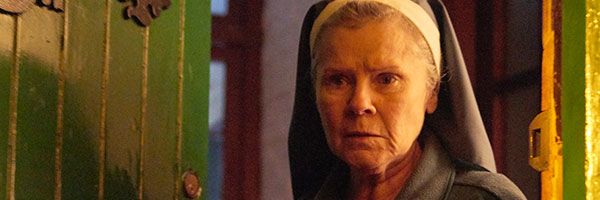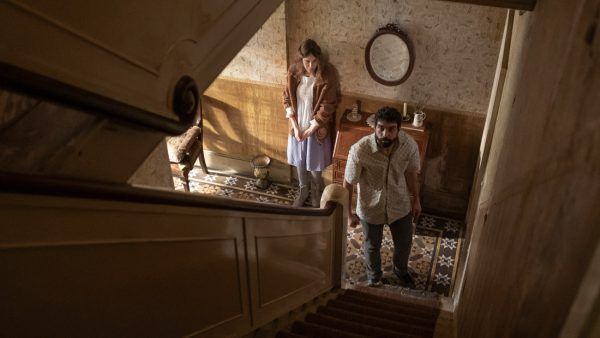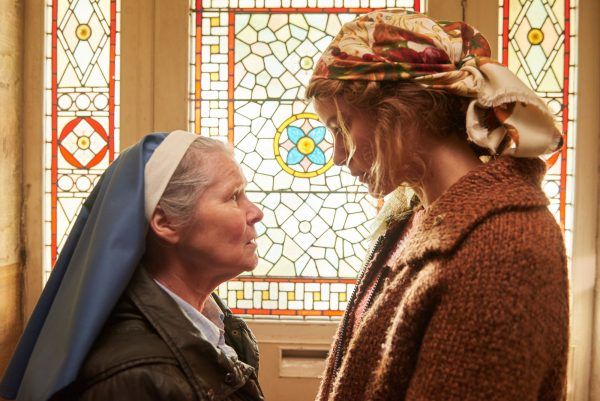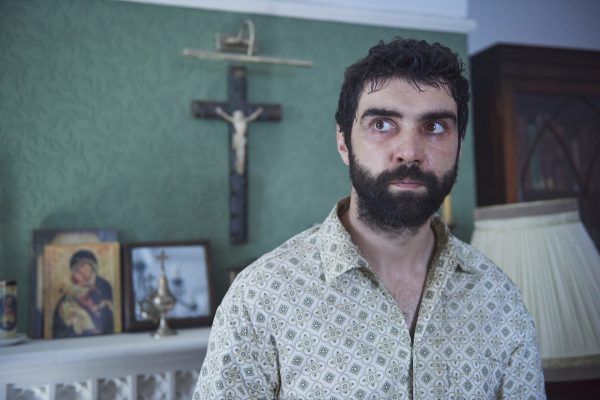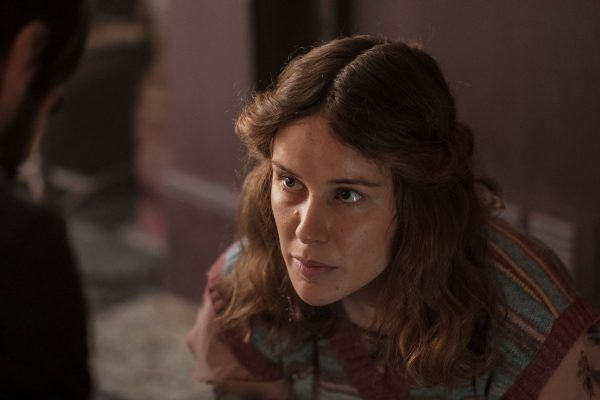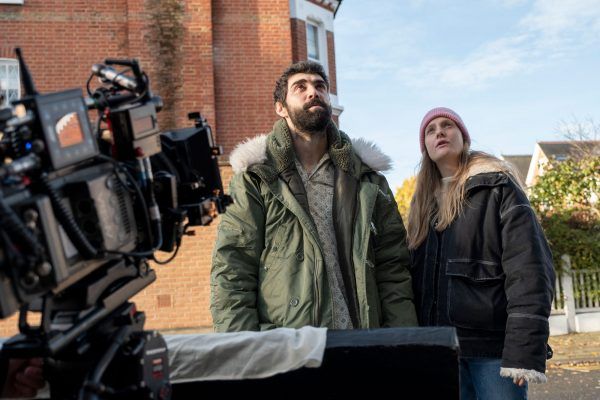[Editor's note: The following contains spoilers for Amulet.]
So, you watched Amulet. How are you feeling right now? Whether you’re into the movie or not, I’d like to bet it sparked a pretty strong response - and perhaps some questions about the mythology and its stance on forgiveness in the process.
Since catching the film at the 2020 Sundance Film Festival, I haven’t been able to stop thinking about Romola Garai’s feature debut. You spend about two thirds of the film unpacking the mystery of Thomas’ (Alec Secareanu) past and what’s going on in that attic and then, all of a sudden, you’re hit with one major reveal after the next. Sister Claire (Imelda Staunton) isn’t really a nun at all. The being upstairs isn’t Magda’s (Carla Juri) mother, but rather a man being punished for the atrocities he’s committed. And then, to top it all off, Thomas is about to be subjected to that same exact fate and there’s nothing he can do about it. It’s an extremely ambitious and chilling tale about atonement that also addresses what it means to be a woman in this world. Garai takes all of that and packages it into this vicious cycle of targeting sources of evil and making them pay for what they’ve done in the most gruesome way.
As much as I enjoyed chatting with Garai, Secareanu and Juri in Park City back in January, now that the movie is available to watch, I was mighty eager to reconnect with Garai to dig into plot spoilers. Check out our conversation below to learn more about what inspired this mythology, what Magda really is, an especially brutal alternate ending Garai once considered, and so much more!
To start, what was the inspiration behind the mythology?
Romola Garai: The goddess figurine is just pure invention, but I suppose the sources that we used were early neolithic art. And it definitely comes from an idea of a pre-Christian, matrilineal, matriarchal religion or religiosity that doesn't necessarily favor forgiveness so much. Because, you know, there's this kind of gentle invitation to ask whether the invention of Christianity’s emphasis on forgiveness is a slightly taller order when you are a woman or anybody who's not in power. So, I guess the mythology comes from a pre-Christian time, influenced a little bit by maybe Greek ideas or neolithic art and early religions, paganism.
How long has Imelda Staunton's character been the ringleader of this cycle?
Garai: I suppose the idea is that she's a human, so there's nothing in the film to intimate that she's not a human being. She never was anything other than that in my mind. But Magda, she has a human incarnation, but in reality she is this pre-Christian pagan deity. So in my mind, I had this idea that she has a human counterpart, like a handler; she needs someone to help her out to do her business. So we have that figure, but the other part of her needing to survive is that she also has a human male who births these offspring that is like an incarnation of pure evil. So she has a human being, like Imelda, who's a sort of handler figure and then this man that's a kind of waste pipe if you like, of evil.
So when they have that conversation where she tells Thomas that he is going to get to choose his handler, does that mean the character of Magda takes on a different form based on who the male victim is?
Garai: No, I don't think so. I think it's more that what she says is not untrue, but he just interprets it wrongly. So, for a split second, Thomas thinks, ‘Oh, I'm this evil creature. I am a demon. I have become a demon because of this evil thing in my past.’ So again, it's this attempt in the film to constantly play with the idea of who's the villain and who’s the victim? So, for a moment he thinks, ‘Oh, I'm the villain, the all powerful villain.’ And, she says, ‘Oh, well, that person needs someone to help them out. And maybe you need someone to do that.’ And he's, ‘Well, I know a woman who's already doing everything that I tell her to do.’ So for that moment he thinks, ‘Oh, I'll just get Magda who's happy to make my food and stuff to do that job.’ But of course, he's misinterpreted what she said, because actually the truth is of course that he is that creature, that she is the villain, if you like, this all powerful villain depending on how you look at it, but she is the all powerful creation and he is going to be her servant, slave.
Have you noticed a difference between how men and women respond to the movie?
Garai: I suppose there's the people in my life and their responses to it, and then there's the public response, which is a different thing. I think I would probably feel more comfortable talking about my own friends, the people in my life. And I think in my life, I've seen in general - and this is a huge generalization as a caveat - sometimes an unwillingness in women to accept a very, very vengeful film. Because it's not what we're raised for, you know? And, it's a very vengeful film; it kind of posits the idea that forgiveness and turning the other cheek is maybe not the way, particularly if people haven't asked for forgiveness. And sometimes I feel like with my female friends who I definitely have felt like would be maybe more up for that, maybe more up for the film than a man, that they've been resistant to that idea, occasionally. But then also you have the conversations with guys who are just, ‘Why are women allowed to make these films? They're just running around all over the place making these horrible films that are really, really threatening.’ [Laughs] So, I mean, I guess it's a mix.
Who leaves the amulet for Thomas to find in the first place? Or is it a situation where it finds him because it knows what he's tempted to do?
Garai: Yeah, it's totally that. It's completely that. I think he finds it, not because he's looking for it or because it seeks him out, but because it knows that he has the capacity for evil. Or, you know, maybe another person would find it and nothing would happen. But it's a witness to what he does and a symbol, if you like, of the silence of women who watch this cycle of male violence continue through the ages. But, there were a fair enough people who told me, ‘You should probably nail that down because it looked a bit like maybe the amulet has made him evil.’ And I was, ‘No! Nobody's ever going to think that.’
And then, how does the value of the amulet change when Magda gives it to Miriam? Is it a piece that you envision Miriam keeping for the rest of her life so that she never forgets?
Garai: Yeah, I think it's just a way of her saying that, ‘You weren't alone in the woods,’ you know? ‘That thing didn't happen alone; you weren't alone and he didn't get away with it.’ I suppose I was trying to give a cathartic ending to the storyline of the flashback. And I definitely really wanted the film to end on that. We had a lot of conversations about ending the film with Thomas’ birth and he's got a screaming face, which would have been fun as well. We actually did do a shot of him screaming into the camera for five minutes because I had this idea that maybe we could just run the whole credits over it. [Laughs] He had a very sore throat that day. But, in the end, I wanted something that was a bit more sly, yes, and maybe a bit humorous, but more optimistic. So, yeah, the idea is that she gives her the amulet in a sense of that she wasn't alone in the woods.
Where do you think that Magda is taking Thomas now?
Garai: She's just gonna go somewhere else and find another guy that's done something bad. And Thomas is gonna become the man in the attic and he's gonna be up there giving birth to these rat babies,which are his own evil for a really, really long time probably.
With the bats, did you always know that you were gonna go with a rat-bat-like creature or did you ever toy with some other ideas for that?
Garai: No, no. We looked at lots of different kinds of art. We had a great concept designer. Originally I had this idea that if we made it look cute, like a Furby or something, then he'd bring it out of the water and it would look like an unthreatening creature and then it would turn into something really disgusting when it sprung into life, but there was just no way to do that. It always just looked funny. And so, I mean, I think my toleration for things being disgusting and dark and weird and humorous is probably higher than average. [Laughs] But it was good that we didn't do that. And in the end, I think we ended up with a creature that was just perfect. It's small, it's not a big animal. It could, if it was going really quickly, not be something that would necessarily draw the eye but when you look at it closely, it’s clearly a monster, you know?
Do you think it's possible to be absolved from such extreme acts like what Thomas does or did he never even stand a chance?
Garai: No, I don't think he stood a chance because he was never really prepared to accept what had happened. I just don't believe that you can move on until there's been a reckoning. And I feel like people often say, ‘Well, let's just move on,’ you know? And I question the validity of that because I just think that in the long term, and particularly when you look at generations, people inherit their anger from their parents. Time does not heal everything. And I suppose I do feel like it's a worthwhile thing to say that forgiveness should always be given when it's been asked for. But to say it should always be given even when it hasn't been asked for it's a bit like, well, I don't know; does that bring you any kind of closure? But, I mean, it's a question more than a statement, I suppose. I would say that that question was very much open in my mind, and not in everyone’s, but definitely for me.
Do you think that over the course of her time doing this that Magda has ever come across a victim who has that reckoning and turns the corner during the process?
Garai: Oh, I hope so. I have not given that a single second thought but I'd love to see the house that she went into sometime in her very long life in medieval England, or wherever, where she met someone who said, ‘Oh, actually you've said you don't really want me to be here.’ And, ‘Why would I let a woman cook and clean for me who said that she doesn't want me here?’ And, ‘Why would I impose myself on someone else because I feel the deep need to be good all the time?’ I certainly think it is possible for people to be self aware about themselves in that way.

